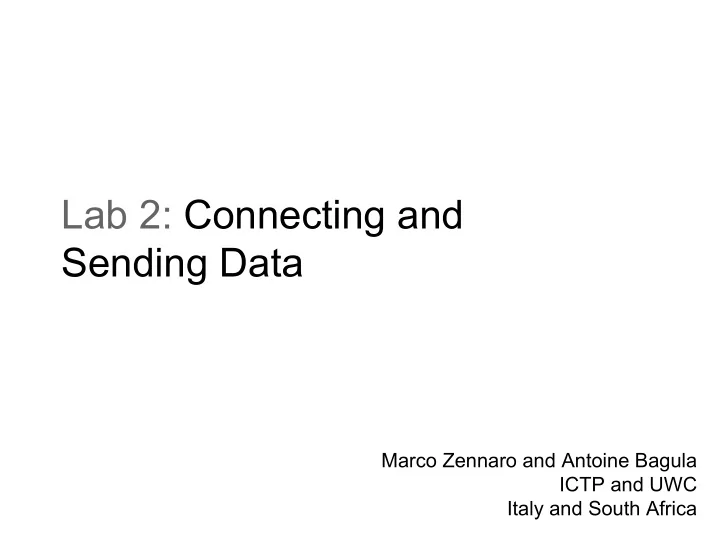

Lab 2: Connecting and Sending Data Marco Zennaro and Antoine Bagula ICTP and UWC Italy and South Africa
Goals of this Lab ● Learn how to connect to the Internet via WiFi ● Excercises about: ● scanning available WiFi networks ● connecting to a WiFi access point ● sending data to plot.ly
Lab Examples From the Workshop's webpage, download the zip file with all the examples for this Lab 2 Session. Open the folder called Example_1 and open the Example_1.ino file
Start!
Example_1 Connect the Ardiono WiFi shield on top of the Seeduino board.
Example_1 Example_1 will scan for available WiFi networks.
Example_1: attention! On the USB device, select 5V in order for the WiFi Shield to work!
Example_1: attention! You need to connect pins #2 and #4 with a cable in order for the WiFi Shield to work!
Example_1 - extended What is the most powerful WiFi Access Point you can see? Try to move and check how the signal level changes. Write down the name of the network you want to connect to.
Example_2 Example_2 will connect to a WiFi network with WPA authentication (password). Adjust the name of the network and the password. #include <WiFi.h> char ssid[] = "yourNetwork"; // your network SSID (name) char pass[] = "secretPassword"; // your network password int status = WL_IDLE_STATUS; // the Wifi radio's status
Example_2 - output
Example_2 - extended What is your IP address? What is the signal level (RSSI)?
Storing your data There are *many* online platforms to store and visualize your data http://postscapes.com/internet-of-things- platforms has a list of platforms I reccomend https://thingspeak.com/ and https://plot.ly/
Storing your data - considerations There are some issues to consider when choosing an online platform: - who owns *your* data? - how reliable is the platform? - will it be online next year? - what about privacy? (how important is your data?) - open source or proprietary?
Storing your data - plot.ly Plotly is a collaborative data analysis and graphing tool. Plotly's Arduino libraries connects Arduinos to plotly's online graphing tool for real-time, interactive data logging and graphing. It's free, open source, and your graphs and data are entirely online.
Example_3 - plot.ly Sign up to plotly : https://plot.ly (it’s free!) Download and uncompress the latest plotly release: https://github.com/plotly/arduino-api/releases
Example_3 - plot.ly Place the plotly WiFi library (called plotly_streaming_wifi) in your Arduino libraries folder: /users/name/XXXXX Restart the Arduino IDE so that the new library is loaded. Load Example_3 from the folder Lab_2.
Example_3 - plot.ly Fill in your plotly username, filename (you choose it) and WiFi information. // Supply as many tokens as data traces // e.g. if you want to ploty A0 and A1 vs time, supply two tokens char *tokens[nTraces] = {"token_1", "token_2"}; // arguments: username, api key, streaming token, filename plotly graph = plotly("plotly_username", "plotly_api_key", tokens, "your_filename", nTraces); int status = WL_IDLE_STATUS; // the Wifi radio's status char ssid[] = "wifi_network_name"; // your network SSID (name) char pass[] = "wifi_network_password"; // // your network password
Example_3 - plot.ly If you want to ploty two variables vs time, upu need to supply two tokens You can find your API key and stream tokens here: https://plot.ly/settings
Example_3 - plot.ly Fill in your plotly API key and stream tokens. // Supply as many tokens as data traces // e.g. if you want to ploty A0 and A1 vs time, supply two tokens char *tokens[nTraces] = {"token_1", "token_2"}; // arguments: username, api key, streaming token, filename plotly graph = plotly("plotly_username", "plotly_api_key", tokens, "your_filename", nTraces); int status = WL_IDLE_STATUS; // the Wifi radio's status char ssid[] = "wifi_network_name"; // your network SSID (name) char pass[] = "wifi_network_password"; // // your network password
Example_3 - output ... Attempting to connect to WPA network... ... Connected to network ... Attempting to connect to plotly's REST servers ... Connected to plotly's REST servers ... Sending HTTP Post to plotly ... Sent message, plotly's response: ... A-ok from plotly, All Streams Go! ... View your streaming plot here: https://plot.ly/~streaming-demos/6 ... Connecting to plotly's streaming servers... ... Connected to plotly's streaming servers ... Initializing stream ... Done initializing, ready to stream!
Example_3 - output The graph and data is saved in your plotly account, so you can view it in your plotly file list here: https://plot.ly/plot . You can view, edit, and share your graphs while data is streaming to them in real-time. Everybody that views the graph will see the exact same data at the same time (try it out yourself: open your graph in two different browser windows).
Example_3 - extended Visit https://github.com/plotly/arduino-api and adjust the code to make the graph: 1) private 2) with 100 points plotted at a time 3) timezone set to Japan.
Exercise I own a chalet in Switzerland and want to monitor its temperature every 2 minutes using an existing WiFi network. I want to visualize how temperature changes over time.
Recommend
More recommend